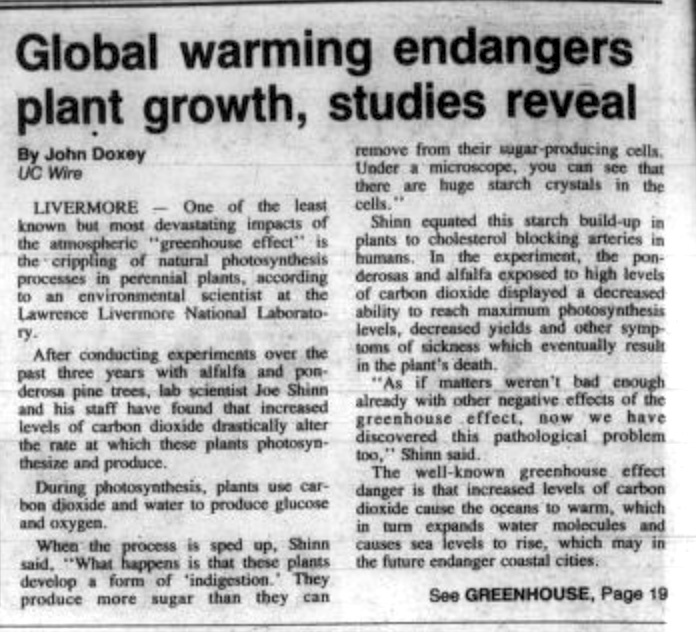Throwback Thursday: Environmental scientist voices major concerns about carbon emission in 1989

(Daily Bruin Archive)
By Elizabeth Hanczor
Feb. 7, 2019 4:14 p.m.
By the mid-1980s, the general scientific and political consensus on climate change was that it is in fact, a major problem.
While our wealth of knowledge has grown significantly since the Daily Bruin ran an article back in 1989 outlining a study made public in January of that year, exploring the basic biological and economic concerns surrounding global warming.
“The greenhouse effect is the most culturally threatening problem in the world today,” said Joe Shinn, a lab scientist at the Lawrence Livermore National Laboratory.
While climate change and its effects are certainly more well-documented today, scientists in the late ’80s were still trying to fully comprehend the basic consequences it would have on plant life. The article delved into the discoveries on the relationship between photosynthesis and excess carbon dioxide.
Notably, Shinn discussed the overall negative impact of greenhouse gases, which was, at the time becoming a hot topic in the media; in his experiments, scientists found that plants exposed to 300 parts per million or more of carbon dioxide became sickly. They worried the most about plants in “unmanaged systems” such as forests. An increase in carbon dioxide emissions was expected to harm acres of plants native to California dramatically; however, it was predicted that cold, northern regions like Siberia would grow warmer and as a result more fit for agriculture.
The science surrounding climate change has only grown more relevant since the article ran.
Dramatic changes in weather have recently gained attention nationwide – the polar vortex that struck the American Midwest showed record low temperatures, with some areas dipping down to 50 degrees below zero. According to an article in WGBH radio, it’s likely that these intense temperatures were a result of climate change: As temperatures rise in the Arctic, chaotic weather patterns can be expected.
A few months ago, the United Nations’ Intergovernmental Panel on Climate Change released a report explaining that in order to neutralize carbon emissions by the year 2050, the global releases must be slashed by 40 to 50 percent over the next 12 years.
Just a year before that report was released, President Trump publicly opposed the Paris Climate Accord. This deal was engineered to hold all signatory countries accountable for their business practices and consequent emissions and environmental impact.
And students at UCLA apparently are not doing a great job at addressing their part of the problem, either, according to a recent report from UCLA Transportation. The nearly 11,000 Ubers and Lyfts circling the campus each week are only adding to the emissions of carbon dioxide into the atmosphere.
Simply put, a lot has happened in 30 years, but one thing is for certain: The implications for culturally ignoring a concern expressed so many years ago are huge.
“I’m affected tremendously and have a fatal feeling (about the carbon dioxide increase),” Shinn said. “We can’t control the the carbon dioxide production and we have little hope of ever controlling it.”


